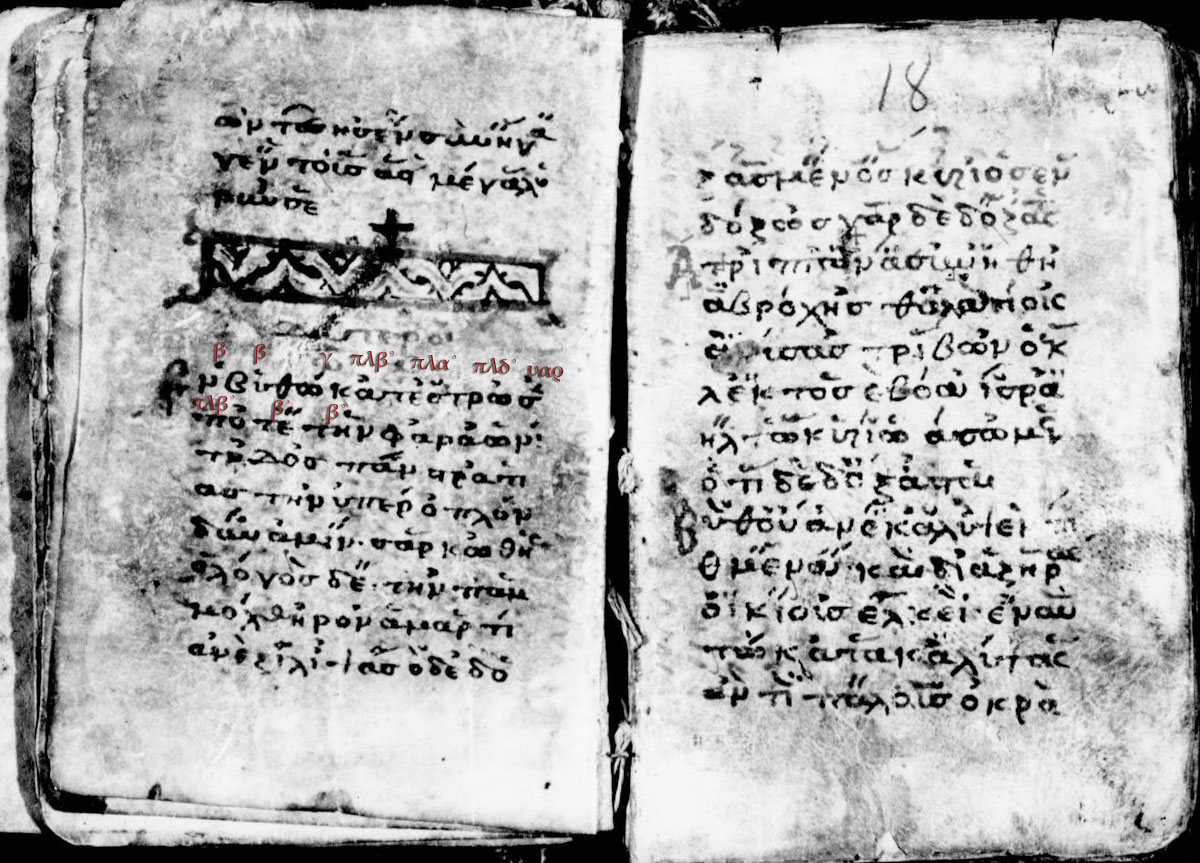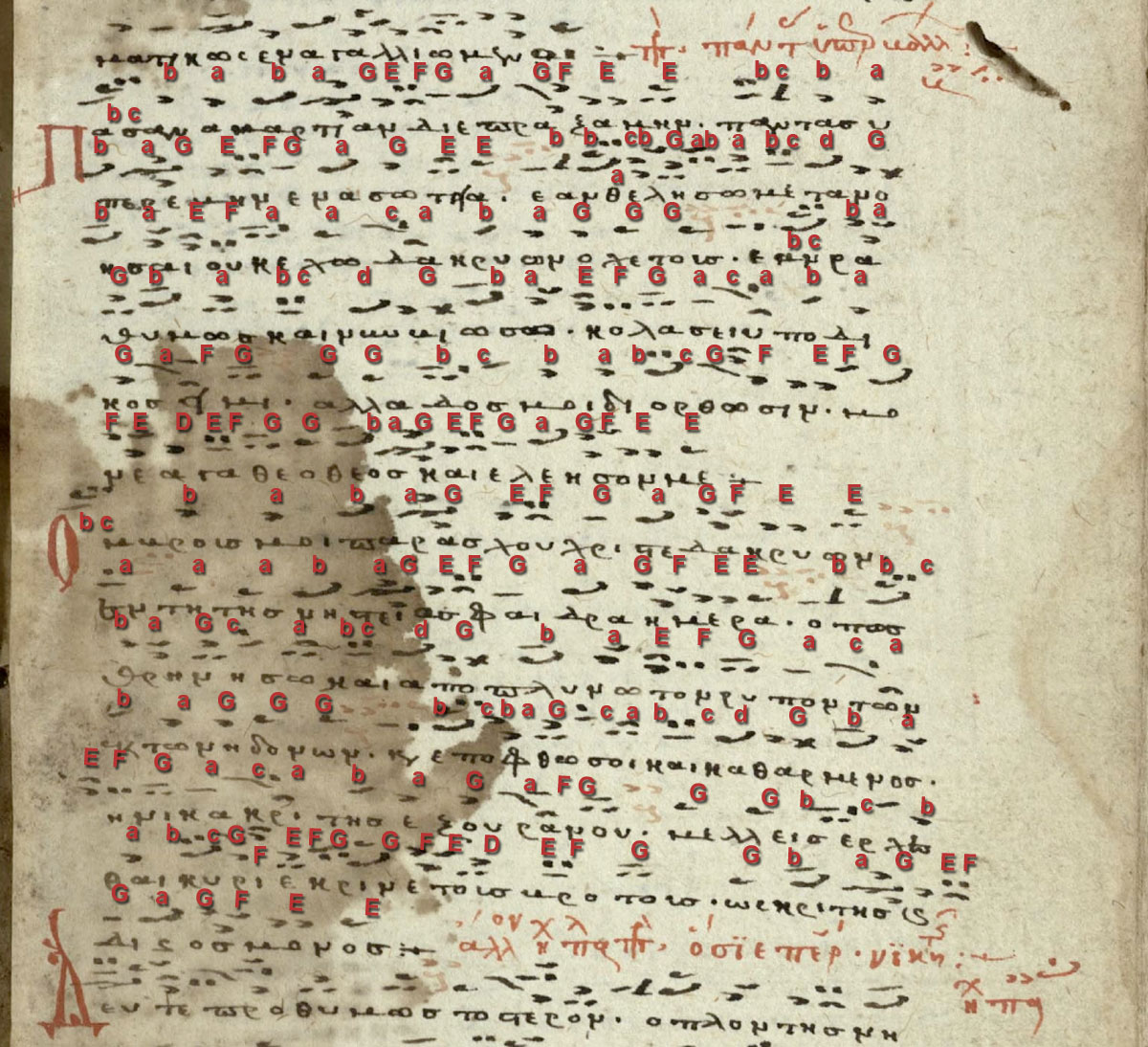|
Irmologion
Irmologion ( ) is a liturgical book of the Eastern Orthodox Church and those Eastern Catholic Churches which follow the Byzantine Rite. It contains irmos, ''irmoi'' () organised in sequences of odes (, sg. ) and such a sequence was called canon (hymnography), ''canon'' ( 'law'). These canons of nine, eight, four or three odes are supposed to be chanted during the morning service (Orthros). The book ''Irmologion'' derives from ''irmos, heirmos'' () which means 'link'. The is a melodic model which preceded the composition of the odes. According to the etymology, the book 'collects' ( ) the . The melodic irmos and the odes of the canon and its use during the morning service An important portion of Matins and other services in the Orthodox Church is the Canon (hymnography), canon, a long liturgical poem divided into nine strophes with a sophisticated meter called ode. Each ode and its prosodic meter is made according to a certain irmos, and concerning its celebration during Orthro ... [...More Info...] [...Related Items...] OR: [Wikipedia] [Google] [Baidu] |
Liturgical Book
A liturgical book, or service book, is a book published by the authority of a church body that contains the text and directions for the liturgy of its official Church service, religious services. Christianity Roman Rite In the Roman Rite of the Catholic Church, the primary liturgical books are the Roman Missal, which contains the texts of the Mass (liturgy), Mass, and the Roman Breviary, which contains the text of the Liturgy of the Hours. With the Mass of Paul VI, 1969 reform of the Roman Missal by Pope Paul VI, now called the "Ordinary Form of the Roman Rite", the selection of Scriptural readings was expanded considerably and thus required a new book called the Lectionary. The Roman Ritual contains the texts for administering some Sacraments of the Catholic Church, sacraments other than the Mass (liturgy), Mass such as baptism, the Sacrament of Penance (Catholic Church), sacrament of penance, the Anointing of the Sick (Catholic Church), anointing of the sick, and the sacram ... [...More Info...] [...Related Items...] OR: [Wikipedia] [Google] [Baidu] |
Canon (hymnography)
A canon () is a structured hymn used in a number of Eastern Orthodox services. It consists of nine ''odes'', based on the Biblical canticles. Most of these are found in the Old Testament, but the final ode is taken from the Magnificat and Song of Zechariah from the New Testament. The roots of this type of hymn go as far back as the 5th century, reaching maturity in the Greek language through the work of St. Andrew of Crete, whose penitential '' Great Canon'' is still used on certain occasions during Great Lent. It was further developed in the 8th century by Sts. John of Damascus and Cosmas of Jerusalem, and in the 9th century by Sts. Joseph the Hymnographer and Theophanes the Branded. Over time the canon came to replace the , a vestigial form of which is still used on several occasions and which has been incorporated into the performance of the canon. Each canon develops a specific theme, such as repentance or honouring a particular saint. Sometimes more than one canon ... [...More Info...] [...Related Items...] OR: [Wikipedia] [Google] [Baidu] |
Byzantine Rite
The Byzantine Rite, also known as the Greek Rite or the Rite of Constantinople, is a liturgical rite that is identified with the wide range of cultural, devotional, and canonical practices that developed in the Eastern Christianity, Eastern Christian church of Constantinople. The canonical hours are extended and complex, lasting about eight hours (longer during Great Lent) but are abridged outside of large Monastery, monasteries. An iconostasis, a partition covered with icons, separates Sanctuary#Sanctuary as area around the altar, the area around the altar from the nave. The Sign of the cross#Eastern Orthodoxy, sign of the cross, accompanied by bowing, is made very frequently, e.g., more than a hundred times during the Divine Liturgy#Byzantine Rite, divine liturgy, and there is prominent veneration of icons, a general acceptance of the congregants freely moving within the church and interacting with each other, and distinctive traditions of liturgical chanting. Some traditional ... [...More Info...] [...Related Items...] OR: [Wikipedia] [Google] [Baidu] |
Irmos
The irmos (or heirmos from ) in the Byzantine liturgical tradition is the initial troparion of an ode of a canon.Nativity Epistle of Metropolitan Laurus, First Hierarch of the Russian Orthodox Church Outside of Russia The meter and melody of an irmos is followed by the remaining troparia of the ode; when more than one canon is used (as is typical at matins), only the first canon's irmos is sung, but the irmoi of the subsequent canons must be known in order to determine an ode's melody and so, even in canons where it is known that the irmos is never sung, the irmos is nonetheless specified. Note that in the Russian tradition, often only the irmos is sung, the rest of the ode simply being read; in Greek parishes, often the remaining troparia are simply eliminated, but in non-Russian traditions, all troparia of a canon are sung The term comes from the Greek verb "to tie, link" meaning that it poetically connects the Biblical ode to the subject of the canon. Because the irmos pres ... [...More Info...] [...Related Items...] OR: [Wikipedia] [Google] [Baidu] |
Canon (hymnography)
A canon () is a structured hymn used in a number of Eastern Orthodox services. It consists of nine ''odes'', based on the Biblical canticles. Most of these are found in the Old Testament, but the final ode is taken from the Magnificat and Song of Zechariah from the New Testament. The roots of this type of hymn go as far back as the 5th century, reaching maturity in the Greek language through the work of St. Andrew of Crete, whose penitential '' Great Canon'' is still used on certain occasions during Great Lent. It was further developed in the 8th century by Sts. John of Damascus and Cosmas of Jerusalem, and in the 9th century by Sts. Joseph the Hymnographer and Theophanes the Branded. Over time the canon came to replace the , a vestigial form of which is still used on several occasions and which has been incorporated into the performance of the canon. Each canon develops a specific theme, such as repentance or honouring a particular saint. Sometimes more than one canon ... [...More Info...] [...Related Items...] OR: [Wikipedia] [Google] [Baidu] |
Chrysaphes The Younger
Panagiotes the Protopsaltes or Panagiotes the New Chrysaphes (; – after 1682) was a Greek composer, '' protopsaltes'' (first cantor) and poet in Constantinople, the capital of the Ottoman Empire. Life and work He served as ''protopsaltes'' of the Ecumenical Patriarchate of Constantinople (about 1655 to 1682) and like the former ''protopsaltes'' Theophanes Karykes he became engaged in a revival of the Byzantine psaltic art or art of chant. As student of the patriarchal ''protopsaltes'' Georgios Raidestinos, his approach was based on the recomposition of the late medieval sticherarion as it was described by Manuel Chrysaphes in his treatise about psaltic art, and the recomposition of the Byzantine '' Anastasimatarion'' was based on the simple psalmody according to the Octoechos. Several manuscripts of the latter have survived since the 17th century and they were usually introduced by a ''Papadike'' treatise, the basic introduction (''protheoria'') into psaltic art.Not only in ... [...More Info...] [...Related Items...] OR: [Wikipedia] [Google] [Baidu] |
Menaion
The Menaion (; Slavonic: Минїѧ, ''Miniya'', "of the month") is the liturgical book used by the Eastern Orthodox Churchand those Eastern Catholic Churches which follow the Byzantine Rite containing the propers for fixed dates of the calendar year, ''i.e.'' entities not dependent on the date of Easter. The Menaion is the largest volume of the propers for the Byzantine Rite and is used at nearly all the daily services. Editions The complete Menaion is published in twelve volumes, one for each month; the first volume is for September which commences the Byzantine liturgical year. The Festal Menaion is an abridged version containing texts for those great feasts falling on the fixed cycle, some editions also containing feasts of the major saints. The General Menaion contains services for each type of celebration ( apostles, martyrs, etc.) with blank spaces for the name of the saint(s) commemorated. Originating before the invention of printing when the enormous volume of the ... [...More Info...] [...Related Items...] OR: [Wikipedia] [Google] [Baidu] |
Avtomela
(Medieval Greek: from , 'unique' and , 'melody'; Church Slavonic: , )—pl. ''idiomela''—is a type of sticheron found in the liturgical books used in the Eastern Orthodox Church, the Eastern Catholic Churches which follow the Byzantine Rite, and many other Orthodox communities like Old Believers. are unique compositions, while or —sing. , or (Medieval Greek: , Church Slavonic: , )—were used to create other hymns by a composition over the 's melody and following the poetic meter provided by the musical rhythm. The genre composed over these was characterised as or (Medieval Greek: 'similar to', Church Slavonic: , ). Definition of ''idiomelon'', ''avtomelon'' and ''prosomoion'' The hymn category can only be understood in comparison with and . Already in the older book Tropologion each melody of a certain hymn was classified by a modal signature of the Byzantine octoechos—the eight-mode system as it had developed in Constantinople, Damascus, Jerusalem, and in ma ... [...More Info...] [...Related Items...] OR: [Wikipedia] [Google] [Baidu] |
Syriac Sertâ Book Script
Syriac may refer to: * Suret, a Neo-Aramaic language * Syriac alphabet, a writing system primarily used to write the Syriac language ** Syriac (Unicode block) ** Syriac Supplement * Syriac Christianity, a branch of Eastern Christianity * Syriac language The Syriac language ( ; ), also known natively in its spoken form in early Syriac literature as Edessan (), the Mesopotamian language () and Aramaic (), is an Aramaic#Eastern Middle Aramaic, Eastern Middle Aramaic dialect. Classical Syriac is ..., an Eastern Middle Aramaic dialect * Syriac literature, literature in the Syriac language * Syriac studies, the study of the Syriac language and Syriac Christianity * Syriacs (term), term used as designations for Syriac Christians * Syriac people, another term for Assyrian people See also * * Syriac Rite * Syrian (other) * Syria (other) * Suriyani {{disambiguation Language and nationality disambiguation pages ... [...More Info...] [...Related Items...] OR: [Wikipedia] [Google] [Baidu] |
Petros Bereketis
Petros Bereketis () or Peter the Sweet (Πέτρος ο Γλυκής) was one of the most innovative musicians of 17th-century Constantinople (Ottoman period). He, together with Panagiotes the New Chrysaphes, Balasios the Priest and Germanos Bishop of New Patras was one of the most influential figures in the evolution of the Byzantine music, Byzantine psaltic art following the fall of Constantinople in 1453, although he never was associated with the Patriarchate in Fener. For many years, he served as the protopsaltis (first cantor) of the parochial church St. Constantine of the Samatya, Hypsomatheia (Samatya) quarter close to the Sea of Marmara, Marmara coast. During his lifetime, which is approximately supposed to be between 1665 and 1725, while Chrysanthos mentioned that he served there in the time of the Archon Protopsaltis at the Ecumenical Patriarchate of Constantinople, Great Church of Christ of Panagiotis Halatzoglou and his Lampadarios John Trapezountios (1727–1748). Ed ... [...More Info...] [...Related Items...] OR: [Wikipedia] [Google] [Baidu] |



